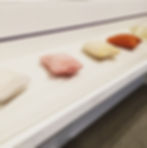'Tis the Season for Fabulous Exhibits
- annebarnesstudio
- Oct 20, 2018
- 4 min read
Updated: Jul 23, 2019
Just some of the art that I have consumed recently. . .

Rachel Whiteread
I was able to explore Rachel Whiteread’s exhibit when it first opened back in September at the National Gallery of Art and it was a revelation to me. Whiteread is an English sculptor who casts objects and spaces from everyday life, and her work "captures the human imprint on abandoned, worn, and often overlooked" places and spaces. She is an artist who specializes in areas that most of us don't give much, if any, thought to.

By casting the interiors or undersides of everyday objects Whiteread turns them into something totally different from their exterior selves. She accomplishes this by infusing a forgotten or overlooked hidden space into a solid, precious object, effectively turning the secret interior life of the object outward and to the forefront so it may be seen and experienced by the viewer.
The grid of resin blocks above reminded me of a larger than life game of chess, but they are actually the casts from the spaces beneath chairs.

Whiteread has been called "a geographer of hidden spaces" and although she is a sculptor and therefore someone from whom I might not be able draw parallels to in my own work, her ideas about making a memory into something solid, do deeply resonate with me. Her work feels like it is a form of memory keeping and this is a theme that I am trying to explore in my own creative practice as well.
By casting the interiors of hot water bottles (above)--objects that radiate comfort and care--the artist has managed to create a solid object out of a feeling.

For example, this cast of the underside of a bed (above) was made shortly after the death of Whiteread's father, and its positioning and solid form suggest a memorial of sorts. Memorializing has been a persistent theme throughout the artist's career, as the wall label for this piece quotes the artist "I somehow managed to make memories solid."
This is definitely a solid and thought provoking exhibit to experience. I am really starting to get how a conceptual idea combined with an artist's memories and life experiences can be played out in very innovative and beautifully unique ways.

Glenstone
My local artist/mentor for this semester, Isabel Manalo, invited me to go with her and a group of women artists to the opening day (October 4, 2018) of Glenstone's new pavilions, visitor's center, and cafe.
Glenstone is a private art museum that was first opened in 2006 by Mitchell and Emily Rales on the grounds of their home in Potomac, MD. What originally consisted of one gallery building and outdoor space, has now been transformed into a sprawling 230-acre campus of buildings to showcase their private modern art collection, all open and free to the public (with a reservation).
The Rales's collection is now up to 1,300 objects and it is considered by many to be one of the greatest private collections of American and European contemporary art in the country.
I didn’t get any pictures of the art inside the new pavilion buildings because they don’t allow photography inside. So you will have to make do with the long shot (above) of the outdoor Jeff Koons piece “Split-Rocker.” I have been to Glenstone once before in the winter when it wasn't in bloom, so it was fun to see it planted and in color.
There was so much to see in the new buildings that I didn't make it out to the original gallery space where there is a longterm exhibit of Louise Bourgeois' work on display. I need to get back soon for that!
It was exciting to go on opening day, and the new buildings and expanded grounds are really amazing. If you are able, I recommend you get out to see it ASAP!

Diana Al-Hadid
I was in NYC the weekend that Peter Rostovsky gave a tour of Petah Coyne's show at Galeria Lelong in Chelsea and Diana Al-Hadid's at the Bronx Museum, but unfortunately I wasn't able to join them because I had matinee tickets to see the Book of Mormon. I was sorry to miss the personalized tour, but luckily I was able to catch Diana Al-Hadid’s amazing exhibition “Delirious Matter” at the Bronx Museum the day after.
After attending Al-Hadid’s artist talk at the June 2018 residency, it was such a treat to be able to see her work in person.
The picture above is of her large scale sculpture “Nolli’s Orders, 2012” with her diptych “South East North West, 2017” in the background. I’m always interested in other artist’s process and I found it fascinating that a few of the materials she used in these works included tin foil and blue painters tape.

Al-Hadid's work, like the one pictured above, manages to be both delicate and very solid at the same time. She has developed a process that combines polymer gypsum, fiberglass, steel, plaster, gold leaf and pigment that makes some of her work read as both painting (due to the shape and dimensions, and how it hangs on the wall) and sculpture at the same time.


“The Sleepwalker, 2014” is a piece of art that is built into a wall, which allows it to function as both image and architecture. I thought the light flowing through the back and the shadows that it cast were as beautiful as the front of the piece.

“In Mortal Repose, 2011” is another piece that displays Al-Hadid's ability to make something appear both solid and fleeting at the same time. The materials in this work are traditional and substantial, but the imagery of the melting and disappearing bust conveys something that is slipping from your grasp. It's pleasing and unsettling, which I feel might just be the point.
